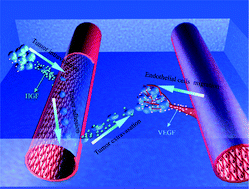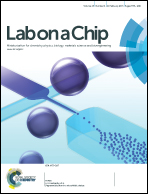An artificial blood vessel implanted three-dimensional microsystem for modeling transvascular migration of tumor cells†
Abstract
Reproducing a tumor microenvironment consisting of blood vessels and tumor cells for modeling tumor invasion in vitro is particularly challenging. Here, we report an artificial blood vessel implanted 3D microfluidic system for reproducing transvascular migration of tumor cells. The transparent, porous and elastic artificial blood vessels are obtained by constructing polysaccharide cellulose-based microtubes using a chitosan sacrificial template, and possess excellent cytocompatibility, permeability, and mechanical characteristics. The artificial blood vessels are then fully implanted into the collagen matrix to reconstruct the 3D microsystem for modeling transvascular migration of tumor cells. Well-defined simulated vascular lumens were obtained by proliferation of the human umbilical vein endothelial cells (HUVECs) lining the artificial blood vessels, which enables us to reproduce structures and functions of blood vessels and replicate various hemodynamic parameters. Based on this model, the adhesion and transvascular migration of tumor cells across the artificial blood vessel have been well reproduced.

- This article is part of the themed collection: Implantable Devices

 Please wait while we load your content...
Please wait while we load your content...